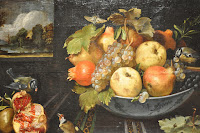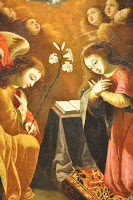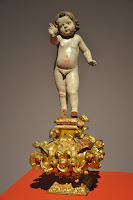The temporary exhibition of Josefa de Obidos, which I was keen on seeing, provided viewers with a thorough insight into who she really was as far as painting in Portugal is concerned, together with the role she played in regards to the Portuguese Barroque painting, of which she became the most highly reputed exponent in Portugal.
In one of the several exhibit galleries a series of life still paintings set the painting scenario of the epoch in regards to the compositions, which in Spain (through 1630-40) had in Francisco Barrera one of the greatest inspirations, which in turn followed similar Flemish model schemes including allegorical personifications of each season and displayed fruits to be found at a particular time of the year.
In one of the several exhibit galleries a series of life still paintings set the painting scenario of the epoch in regards to the compositions, which in Spain (through 1630-40) had in Francisco Barrera one of the greatest inspirations, which in turn followed similar Flemish model schemes including allegorical personifications of each season and displayed fruits to be found at a particular time of the year.
Still life with fruits, birds and landscape by Juan Van der Hamen y Léon - 1632 (left). Summer (from the series Four Seasons) by Francisco Barrera - 1638 (right).
Still life with a basket of cherries and a basket of apricots by Juan Sanchéz Cótan - 1600
A series of still life paintings in the manner of the Sevillan bodégon by Josefa de Óbidos and/or her father evoking the months of the year did naturally catch the viewers' attention, not only because they were made more understandable thanks to the inscriptions placed underneath the major theme of the composition adapted to motifs of the represented season but also because of the reference to festivities therewith associated, which most people would identify themselves with.
March by Josefa de Óbidos and/or Baltazar Gomes Figueira - oil on canvas - 1668 (left). April by Josefa de Óbidos - 1668 (right)
Still life with cakes by Baltazar Gomes Figueira - 1660-70
Still life with fruits, vegetables and flowers by Josefa de Óbidos - 1660-70 (left). Still life with watermelon and grapes by Josefa de Óbidos - 1670 (right)
"Agnus Dei", the lamb of God, seems to have been created after the widely known Zurbarán's composition. It is in fact said she follwed Zurbarán's works rather closely.
The Immaculate Conception (after an engraving by the Flemish artist Raphael Sadler) by Francisco Zurbarán - 1628-30
A series of gilded and polychromed terracota reliquary busts of the Virgin Mary, St. Sebastian and a holy nun did invariably catch the viewers' attention and set the epoch. According to provided information they all came from the Monastery of Alcobaça.
The Annunciation by Josefa de Óbidos - oil on canvas - 1676 (left).Virgin Mary with Cistercian Saints by Josefa de Óbidos - 1660-70 (right).
Josefa's earliest works are said to have been painted in copper and it is almost certain that her father had her prepared for a career as a small format painter, which seemed to be a lot more appropriate for a female artist working in a household environment.
Virgin with the child - oil on copper -1660 (left). Virgin with the child - oil on copper - 1667 (right)
We came across quite a few rather interesting paintings of Jesus seen as a child encircled in garlands of flowers, which belong to a series of such similar compositions Josefa replicated throughout her entire career as a painter.
Jesus, Salvator Mundi as a child by Josefa de Óbidos - 1684
The adoration of the shepherds by Josefa de Óbidos - 1669.
Despite the religious motif of the painting one should note the artist still life skills and the detail of the basket of chouriços, clearly highlighting the peculiarity of the composition.


The rest on the flight to Egypt by Baltazar Gomes Figueira - (left). The Holy Family by Josefa de Óbidos - 1672 (right)
St. Teresa of Ávila before the Holy Spirit by Josefa de Óbidos - 1672 (left). The ecstasy of St. Teresa of Ávila by Josefa de Óbidos - 1672 (right).
18th century figurative Portuguese sculpted Salvator Mundi (left). The praying Virgin by Jan Van Kessel I- 1648 (right)
Late 17th century sculpted figures from a retable and the holy family sculpted by Friar Cipriano da Cruz completed the setting of the religious scenario of the epoch.


I felt the exhibition was very well organised and above all representative of the epoch in which Josefa de Óbidos lived. Assembling so many of her works and some of her father's further added to the insight of who she really was.


































Super!!!______________Thanks, Iolanda
ReplyDeleteThanks for thissintesis of a beautiful and interesting exhibition. I am especially grateful for the photography with a good definition of the "Mês de Março": I'm especially interested by the back ground who could be an interpretation of the lagoon of Óbidos by the time. How did you get it? May I use it in a cultural/touristic brochure?
ReplyDeleteThank you for your favourable comment on the synthesis of the exhibition I wrote about. I just took the photos at the exhibition itself. You are welcome to use the photo for your touristic brochure, which I would be glad to receive as well.
Delete